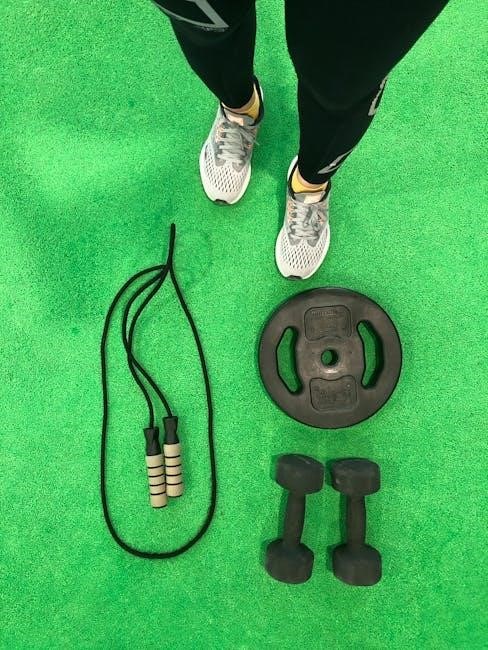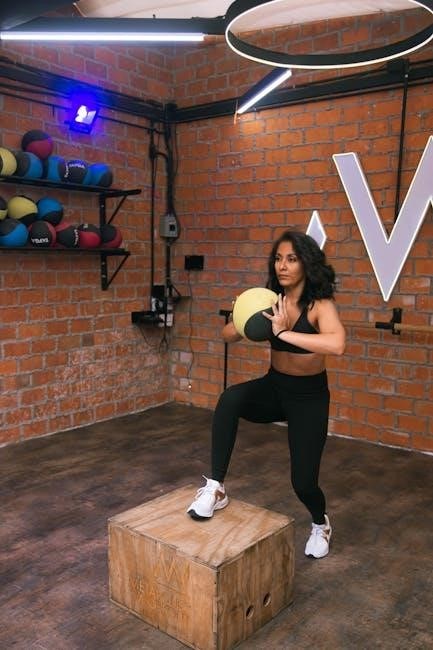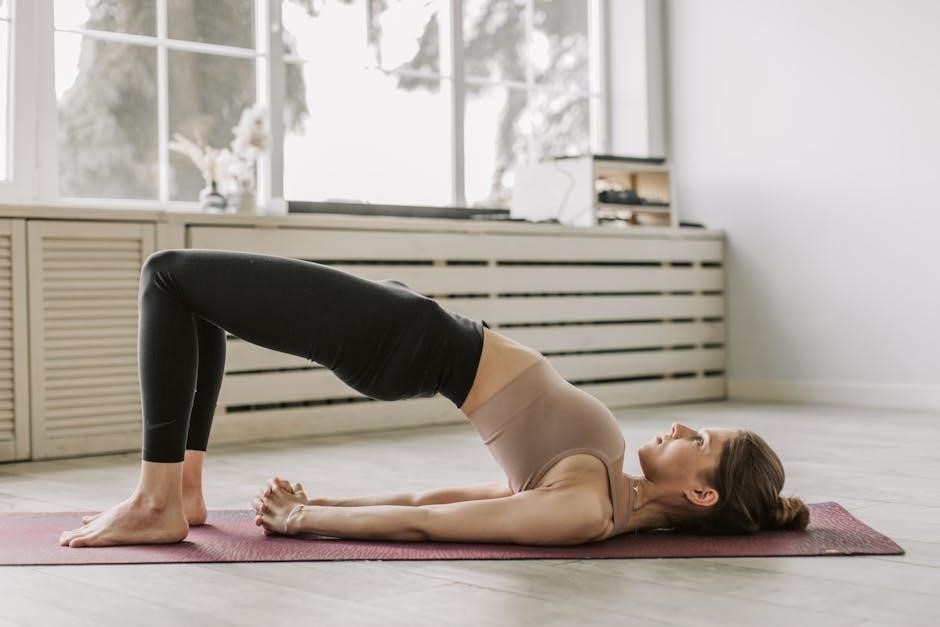High-Intensity Interval Training (HIIT) is a time-efficient workout perfect for beginners. It combines short bursts of intense exercise with brief rest periods‚ promoting weight loss and improved fitness.
1.1 What is HIIT?
HIIT‚ or High-Intensity Interval Training‚ is a workout method involving short bursts of intense exercise followed by brief rest periods. It’s highly efficient‚ typically lasting 15-30 minutes‚ and focuses on maximizing effort during work intervals. This approach boosts heart rate‚ burns calories‚ and improves cardiovascular health. Unlike traditional workouts‚ HIIT alternates between active recovery and all-out effort‚ making it versatile for all fitness levels. It can be done with or without equipment‚ making it accessible for beginners. HIIT’s structure allows for quick and effective sessions‚ perfect for those with busy schedules. Its modifiable nature ensures it can be tailored to individual goals and abilities.
1.2 Benefits of HIIT Workouts
HIIT workouts offer numerous benefits‚ especially for beginners. They are time-efficient‚ delivering impressive results in short sessions. HIIT enhances cardiovascular health by improving heart rate and blood flow. It also boosts metabolism‚ leading to increased caloric burn both during and after workouts. This afterburn effect‚ known as EPOC‚ helps with weight loss. Additionally‚ HIIT improves muscle tone and strength without requiring heavy equipment. It’s versatile‚ allowing customization to suit different fitness levels; Regular HIIT practice also enhances stamina‚ agility‚ and mental discipline. Its scalability makes it ideal for those new to exercise‚ providing a challenging yet achievable path to improved fitness. Overall‚ HIIT is a powerful tool for achieving a leaner‚ stronger body in minimal time.
1.3 Why HIIT is Perfect for Beginners
HIIT is an ideal choice for beginners due to its simplicity and effectiveness. It requires minimal equipment‚ making it accessible for those new to fitness. The short‚ intense intervals are easy to follow and can be modified to suit individual fitness levels. HIIT workouts are also time-efficient‚ fitting into busy schedules. Additionally‚ the variety of exercises keeps routines engaging‚ reducing boredom and increasing motivation. HIIT promotes quick results‚ which can be highly encouraging for newcomers. Its focus on functional movements improves coordination and overall fitness. Most importantly‚ HIIT builds confidence and stamina‚ making it an excellent starting point for anyone embarking on their fitness journey. It’s a great way to kickstart a healthier lifestyle.

Understanding the Basics of HIIT
HIIT involves short bursts of intense exercise followed by brief rest periods. It boosts metabolism and burns calories efficiently‚ making it a popular choice for quick workouts.
2.1 Work-to-Rest Ratio Explained
The work-to-rest ratio in HIIT determines the intensity and recovery balance. Common ratios for beginners include 30 seconds of work to 30 seconds of rest (1:1) or 45 seconds of work to 15 seconds of rest (3:1). These ratios help maintain intensity while allowing recovery. Over time‚ as fitness improves‚ the ratio can be adjusted to increase difficulty. Proper balance ensures effective calorie burn and prevents overtraining. Consistency in maintaining these intervals is key for achieving desired fitness goals and improving overall performance.
2.2 Common HIIT Exercises for Beginners
HIIT workouts for beginners often include simple‚ effective exercises that require minimal equipment. Bodyweight squats‚ push-ups‚ lunges‚ and planks are excellent for building strength and endurance. Jumping jacks and burpees are great for cardiovascular fitness. Mountain climbers and high knees target the core and improve agility. These exercises are easy to learn and can be modified to suit fitness levels; They promote calorie burn and muscle engagement‚ making them ideal for a full-body workout. Incorporating these exercises into a HIIT routine ensures a balanced and efficient session‚ helping beginners achieve their fitness goals without needing advanced skills or equipment. Consistency and proper form are key to maximizing results.
2.3 How to Structure a HIIT Session
A HIIT session for beginners typically starts with a 3-5 minute warm-up‚ including light cardio and dynamic stretching to prepare the body. The core workout involves short bursts of high-intensity exercises‚ followed by brief rest periods. A common ratio is 30 seconds of work to 30 seconds of rest. Beginners can start with 4-6 rounds of 2-3 exercises‚ gradually increasing intensity and duration. Each session should end with a cool-down‚ including static stretches to improve flexibility and lower heart rate. Proper hydration and nutrition are essential for optimal performance and recovery. Consistency is key‚ with at least 2-3 HIIT sessions per week for noticeable results.

Benefits of HIIT for Weight Loss and Fitness
HIIT boosts caloric burn during and after workouts‚ enhances cardiovascular health‚ and increases muscle tone‚ making it an effective approach for weight loss and overall fitness.
3.1 Caloric Burn During and After Workouts
HIIT is renowned for its ability to maximize caloric burn both during and after workouts. The intense bursts of activity push your body to consume more oxygen‚ triggering the afterburn effect‚ known as Excess Post-Exercise Oxygen Consumption (EPOC). This phenomenon increases your metabolism‚ causing your body to burn calories for hours post-workout. Studies show that HIIT can burn up to 15% more calories than traditional steady-state cardio. For beginners‚ this means efficient weight loss and improved fitness in less time. The combination of high-intensity intervals and short rest periods ensures sustained energy expenditure‚ making HIIT a highly effective strategy for calorie burn and long-term weight management.
3.2 Improved Cardiovascular Health
HIIT significantly enhances cardiovascular health by improving the heart’s efficiency. The intense intervals strengthen the heart muscle‚ increasing its ability to pump blood effectively. This leads to better circulation and enhanced endurance. Over time‚ HIIT can lower resting heart rate and blood pressure‚ reducing the risk of heart disease. The short yet powerful workouts are ideal for beginners‚ as they yield substantial cardiovascular benefits without requiring long exercise sessions. Regular HIIT sessions promote a healthier heart‚ boosting overall fitness and longevity.
3.3 Increased Muscle Tone and Strength
HIIT workouts are highly effective for building muscle tone and strength‚ especially for beginners. By incorporating bodyweight exercises like squats‚ lunges‚ and planks‚ HIIT helps target multiple muscle groups simultaneously. The combination of high-intensity bursts and active recovery enhances muscle endurance and promotes lean muscle growth. Over time‚ this leads to improved muscle definition and overall strength. Many HIIT plans for beginners focus on functional movements that strengthen the core‚ legs‚ and upper body‚ making it an efficient way to build muscle without heavy equipment. Consistency in HIIT workouts ensures progressive muscle toning and strength gains‚ making it ideal for those looking to improve their physique and fitness levels.

Safety and Precautions for Beginners
Ensure proper form to avoid injuries. Start slowly‚ focus on technique‚ and gradually increase intensity. Warm-up and cool-down are essential for safety and recovery.
4.1 Importance of Warm-Up and Cool-Down
A proper warm-up prepares the body for HIIT by increasing heart rate and flexibility‚ reducing injury risk. Dynamic stretches like leg swings and arm circles are ideal. Post-workout‚ a cool-down with light movement or static stretches helps lower heart rate gradually‚ preventing dizziness and promoting recovery. Incorporating these routines ensures a safer and more effective workout experience for beginners. Consistency in both warm-up and cool-down routines is crucial for long-term progress and overall health benefits. Neglecting these steps can lead to muscle strain and prolonged soreness‚ hindering your HIIT journey.
4.2 Listening to Your Body
Listening to your body is crucial during HIIT‚ especially as a beginner. Rest when needed to avoid overexertion and prevent injuries. If a movement feels uncomfortable‚ modify or stop. Pay attention to signs like dizziness or sharp pain‚ as they indicate a need to pause. Adjusting intensity based on fitness levels ensures a safe and effective workout. Proper hydration and nutrition are also vital for performance and recovery. By honoring your body’s limits‚ you build a sustainable routine and foster a positive relationship with exercise. Consistency and self-awareness are key to achieving long-term fitness goals without compromising health.
4.3 Avoiding Common Injuries
Avoiding common injuries in HIIT requires attention to proper form and pacing. Overexertion is a frequent issue‚ especially for beginners. Focus on controlled movements during exercises like squats‚ lunges‚ and burpees to protect joints. Knees and lower backs are prone to strain‚ so ensure correct alignment and avoid rounding the spine. Warm-ups and cool-downs are essential to prepare and recover muscles. Start with slower tempos and gradually increase intensity as you build strength and coordination. Proper hydration and rest days also prevent muscle strain. Listening to your body and modifying exercises when needed can significantly reduce injury risks‚ ensuring a safe and effective HIIT journey.

Sample 4-Week HIIT Workout Plan for Beginners
Start with week 1 focusing on total body workouts‚ then progress to upper and lower body focus in weeks 2 and 3‚ finishing with full-body intensity in week 4.
5.1 Week 1: Total Body Workout
Begin with a 3-minute warm-up‚ including light jogging and dynamic stretching. Perform 4 rounds of the following exercises: 30 seconds of work and 30 seconds of rest.
- Bodyweight squats (focus on proper form)
- Push-ups (modify on knees if needed)
- Lunges (alternate legs)
- Plank hold (build core strength)
Finish with a 5-minute cool-down‚ including stretching. This plan introduces HIIT basics‚ ensuring a balanced workout for beginners. Consistency and progression are key for visible results.
5.2 Week 2: Upper Body Focus
Start with a 3-minute warm-up‚ including arm circles and light cardio. Perform 4 rounds of the following exercises with a 30:30 work-to-rest ratio.
- Push-ups (modify on knees if needed)
- Shoulder taps (plank position)
- Burpees (simplified for beginners)
- Mountain climbers (focus on speed)
End with a 5-minute cool-down‚ including stretches for the chest and shoulders. This week emphasizes building upper body strength and endurance‚ ensuring a balanced progression from Week 1.
5.3 Week 3: Lower Body Focus
Begin with a 3-minute dynamic warm-up‚ including leg swings and bodyweight squats. Perform 4 rounds of the following exercises with a 30:30 work-to-rest ratio.
- Bodyweight squats (modify depth as needed)
- Glute bridges (focus on controlled movement)
- Lunges (step-back or walking‚ modified for beginners)
- Calf raises (quick‚ explosive movements)
- Mountain climbers (high knees for intensity)
Finish with a 5-minute cool-down‚ stretching hamstrings‚ quads‚ and calves. This week targets lower body strength‚ endurance‚ and calorie burn‚ building on the foundation established in previous weeks.
5.4 Week 4: Full-Body Intensity
Begin with a 4-minute dynamic warm-up‚ including arm circles‚ leg swings‚ and high knees. Perform 5 rounds of the following full-body exercises with a 40:20 work-to-rest ratio.
- Burpees (modify by stepping back instead of jumping)
- Jump squats (focus on explosive power)
- Push-ups (knee or incline variations if needed)
- Mountain climbers (increase pace for intensity)
- Plank jacks (hold for the full interval)
Include core exercises like Russian twists and bicycle crunches. End with a 5-minute cool-down‚ stretching all major muscle groups. This week challenges endurance and strength‚ preparing you for more advanced HIIT routines.

Nutrition and Recovery Tips
Proper nutrition fuels your HIIT journey. Prioritize clean eating‚ with balanced protein‚ complex carbs‚ and hydration. Adequate sleep is crucial for recovery and muscle repair‚ enhancing performance.
6.1 Clean Eating for Better Results
Clean eating is essential for maximizing HIIT results. Focus on whole‚ unprocessed foods like lean proteins‚ whole grains‚ and fresh vegetables. Avoid sugary snacks and saturated fats to optimize energy levels and recovery. Incorporate balanced meals with healthy fats‚ such as avocados and nuts‚ to support heart health and muscle function. Staying hydrated is also crucial‚ with water and electrolyte-rich drinks aiding performance and post-workout recovery. A well-structured diet enhances endurance‚ accelerates weight loss‚ and supports overall fitness goals‚ making it a cornerstone of a successful HIIT regimen for beginners.
6.2 Hydration and Post-Workout Meals
Hydration is critical for HIIT performance and recovery. Drink water before‚ during‚ and after workouts to maintain energy levels and prevent dehydration. Post-workout meals should balance protein and carbohydrates to replenish energy stores and support muscle repair. Opt for lean proteins like chicken or fish‚ paired with complex carbs such as quinoa or sweet potatoes. Avoid processed foods and excessive sugar to ensure optimal recovery. A protein shake or a meal within 30-60 minutes post-workout can enhance results. Proper hydration and nutrition are key to maximizing the benefits of HIIT‚ such as fat loss and muscle toning‚ while preventing fatigue and injury.

6.3 Importance of Sleep for Recovery
Sleep plays a vital role in recovery after HIIT workouts. During sleep‚ your body repairs muscles‚ replenishes energy stores‚ and enhances physical performance. Aim for 7-9 hours of quality sleep nightly to support muscle growth and mental clarity. Poor sleep can hinder recovery‚ leading to decreased performance and increased injury risk. Establish a consistent sleep schedule and create a relaxing bedtime routine to improve sleep quality. Avoid screens and heavy meals before bed to ensure restful sleep‚ which is essential for maximizing HIIT benefits and maintaining overall health. Prioritizing sleep will help your body recover effectively‚ making your workouts more impactful and sustainable.

Motivation and Consistency
Consistency is key to seeing results from HIIT workouts. Staying motivated by setting achievable goals and tracking progress helps maintain a regular routine. Celebrate small victories to keep momentum strong and remain committed to your fitness journey.

7.1 Setting Realistic Goals
Setting realistic goals is essential for staying motivated and consistent with your HIIT workout plan. Start by identifying specific‚ achievable objectives‚ such as completing three HIIT sessions per week or mastering a new exercise. Celebrate small milestones to build confidence and maintain momentum. For example‚ aim to increase your workout duration or intensity gradually. Tracking progress in a journal or using a fitness app can help you stay accountable. Remember‚ consistency is more important than perfection. By setting clear‚ attainable goals‚ you’ll create a roadmap for success and keep your fitness journey on track. This structured approach ensures steady progress and long-term commitment to your HIIT routine.
7.2 Tracking Progress
Tracking progress is a vital component of a successful HIIT journey. Use a workout journal to log exercises‚ sets‚ and reps to monitor improvements over time. Fitness apps can also track metrics like heart rate‚ calories burned‚ and workout duration. Taking progress photos and measurements helps visualize changes in body composition. Celebrate non-scale victories‚ such as increased energy levels or completing a challenging session. Regularly assessing your progress ensures you stay motivated and adjust your routine as needed. By consistently tracking your journey‚ you’ll gain insights into what works best for your body‚ helping you stay committed to your HIIT workout plan.
7.3 Staying Motivated
Staying motivated is essential for consistency in your HIIT journey. Set realistic and achievable goals to celebrate small victories‚ which will keep you encouraged. Find a workout buddy or join online fitness communities for support and accountability. Reward yourself after reaching milestones‚ such as completing a challenging session or mastering a new exercise. Track your progress visually by sharing achievements on social media or using fitness apps. Remind yourself of your “why” to stay focused on your goals. Additionally‚ mix up your routine to avoid boredom and keep things exciting. A positive mindset and consistent effort will help you stay motivated and committed to your HIIT workout plan.

Additional Resources for Beginners
Explore free HIIT workout PDF guides‚ recommended fitness apps‚ and online communities for support. These resources provide structured plans‚ tracking tools‚ and motivational support to enhance your journey.
8.1 Free HIIT Workout PDF Guides
Discover free HIIT workout PDF guides designed for beginners‚ offering structured plans and exercises. These guides often include warm-up routines‚ exercise lists‚ and nutritional advice to maximize results. Many PDFs provide step-by-step instructions‚ making it easy to follow along at home. They typically cover various fitness goals‚ such as weight loss‚ muscle toning‚ and cardiovascular improvement. Some guides also include tracking sheets to monitor progress. Available on fitness websites‚ social media‚ and apps like MyFitnessPal‚ these resources are perfect for those seeking a cost-effective way to start their HIIT journey. Download a guide today and kickstart your fitness transformation with a clear‚ actionable plan.
8.2 Recommended Fitness Apps
Explore recommended fitness apps that offer HIIT workout plans tailored for beginners. Apps like MyFitnessPal and Fit_Bymarys provide customizable HIIT routines‚ video tutorials‚ and progress tracking. These apps are designed to be user-friendly‚ ensuring a smooth fitness journey. Many offer free versions or trials‚ making them accessible to everyone. With features like timers for work-to-rest intervals and nutritional advice‚ they are perfect for home workouts. Download these apps to access a variety of HIIT plans‚ stay motivated‚ and achieve your fitness goals efficiently. Their availability on both iOS and Android ensures you can train anywhere‚ anytime‚ with expert guidance at your fingertips.
8.3 Online Communities for Support
Joining online communities can provide valuable support and motivation for your HIIT journey. Platforms like Reddit (r/HIIT or r/Fitness) and Facebook groups (e.g.‚ “HIIT Fitness Beginners”) connect you with others sharing similar goals. These communities often share tips‚ workout plans‚ and success stories. You can also find forums dedicated to HIIT where experts and enthusiasts discuss techniques‚ address common challenges‚ and recommend resources. Engaging with these groups helps you stay accountable‚ gain inspiration‚ and learn from others’ experiences. Many communities offer free resources‚ such as downloadable PDF guides or links to beginner-friendly workout plans. Participating in these spaces can enhance your fitness journey and keep you motivated.


